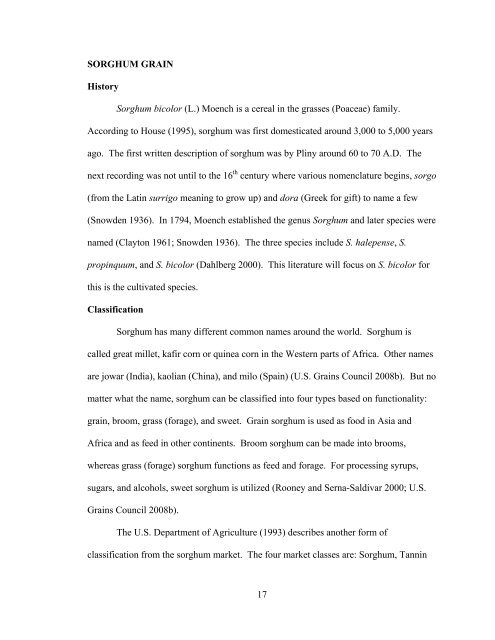EVALUATION OF FOUR SORGHUM HYBRIDS THROUGH THE ...
EVALUATION OF FOUR SORGHUM HYBRIDS THROUGH THE ...
EVALUATION OF FOUR SORGHUM HYBRIDS THROUGH THE ...
You also want an ePaper? Increase the reach of your titles
YUMPU automatically turns print PDFs into web optimized ePapers that Google loves.
<strong>SORGHUM</strong> GRAIN<br />
History<br />
Sorghum bicolor (L.) Moench is a cereal in the grasses (Poaceae) family.<br />
According to House (1995), sorghum was first domesticated around 3,000 to 5,000 years<br />
ago. The first written description of sorghum was by Pliny around 60 to 70 A.D. The<br />
next recording was not until to the 16 th century where various nomenclature begins, sorgo<br />
(from the Latin surrigo meaning to grow up) and dora (Greek for gift) to name a few<br />
(Snowden 1936). In 1794, Moench established the genus Sorghum and later species were<br />
named (Clayton 1961; Snowden 1936). The three species include S. halepense, S.<br />
propinquum, and S. bicolor (Dahlberg 2000). This literature will focus on S. bicolor for<br />
this is the cultivated species.<br />
Classification<br />
Sorghum has many different common names around the world. Sorghum is<br />
called great millet, kafir corn or quinea corn in the Western parts of Africa. Other names<br />
are jowar (India), kaolian (China), and milo (Spain) (U.S. Grains Council 2008b). But no<br />
matter what the name, sorghum can be classified into four types based on functionality:<br />
grain, broom, grass (forage), and sweet. Grain sorghum is used as food in Asia and<br />
Africa and as feed in other continents. Broom sorghum can be made into brooms,<br />
whereas grass (forage) sorghum functions as feed and forage. For processing syrups,<br />
sugars, and alcohols, sweet sorghum is utilized (Rooney and Serna-Saldivar 2000; U.S.<br />
Grains Council 2008b).<br />
The U.S. Department of Agriculture (1993) describes another form of<br />
classification from the sorghum market. The four market classes are: Sorghum, Tannin<br />
17

















